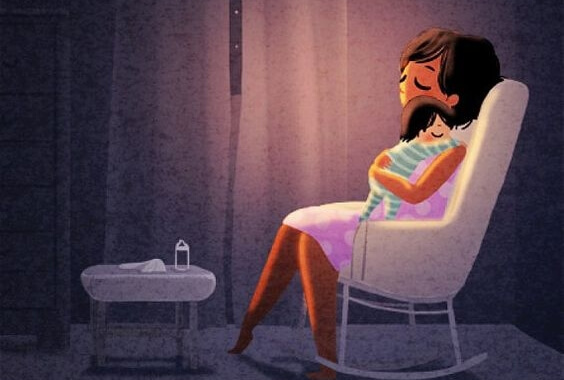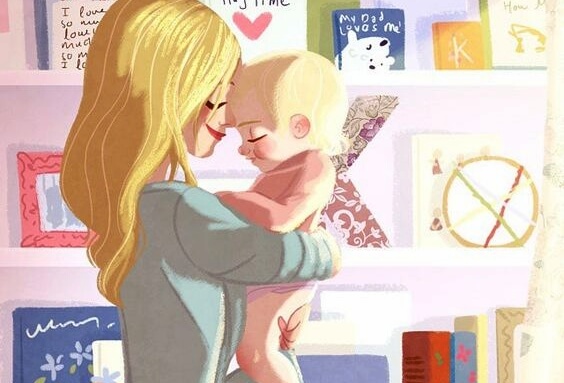How can something so small make me feel so big?


Written and verified by the psychologist Valeria Sabater
Before you could see your baby, or even touch her, you loved her. She filled your dreams before she’d even said her first words. When all she did was sleep and nurse, she was already the most beautiful and perfect creature in the world. How can someone so small and so fragile be capable of making us feel so immense?
That is, without a doubt, one of parenthood’s biggest mysteries. And the answer to that question can’t be put into words. No book or child raising theory offers an adequate explanation.
Even when we don’t bear our children ourselves, but they come into our lives through adoption, we love them with the same intensity. Even if they don’t carry our genetic code, we love our children because they are ours. They are children born of our hearts, and it’s something that adoptive mothers and fathers understand very well.
Of course, there’s always someone eager to remind us of the science behind this explosion of emotions, dreams and even worry concerning these tiny and perfect creatures. They are the clear result of a series of biological processes regulated by oxytocin, the hormone of motherhood. This hormone prepares us to respond to the needs of newborn babies.
But, without a doubt, when we talk about this perfect and inexhaustible love, trying to reduce it to simple biology just doesn’t do it. We love our children in the same way that we breathe.
They are part of us, an extension of our hearts, and there is an imaginary umbilical cord that joins us for life. For us, our children are the image of perfection, the center of our universe that we will always care for, respectfully.
Holding new life in our arms
This magical, unbreakable and essential bond between a newborn and his parents is often ignored in spaces that are dedicated to motherhood. What’s more, we sometimes forget that having children is a two-person job.
We tend to overlook the profound feelings that men also experience when they behold their newborn sons or daughters. This is an unforgettable and transcendent moment for fathers as well.

What we feel is also the product of our own history
Having a child is the result of a process that defines and identifies us. When a woman is in labor in the delivery room, she experiences one of the most special moments of her life. However, everything that leads up to this moment also forms a unique legacy. These previous experiences define the mother, the father and, later on, the child himself.
- It’s very possible that the couple has had difficulties in their quest to become parents. What they feel about the arrival of this baby is something very intense, overwhelming and meaningful.
- At the same time, there are many “rainbow” babies born every day. Their parents carry in their hearts the loss of a previous baby that they will forever remember and hold dear. This memory makes them experience new birth in a different and more intense manner.
- Premature birth is another situation that has a great influence on how parents experience the arrival of a new child. Fear, emotion and suffering accompany this time period as their tiny baby fights for his life. Parents of premature babies are subjected to very complex emotions, where fear and hope dance together in their hearts.
So tiny, and yet I felt your light within me

Pregnant mothers can sense fetal movement as soon as the 7th or 8th week of gestation. However, experienced mothers may identify embryonic movement even sooner.
When a mother senses the fluttering movements of her unborn child, something changes, something lights up. New emotions come to life.
It’s the moment in which she becomes fully aware that she is carrying a life inside of her. Almost without knowing it, an intense, infinite and inmensurable love takes over us in a way we can’t control.
And we let this love flow and carry us away. As weeks and months go by, those fluttering movements become more intense. We dream of our child’s face and we imagine her voice, her smile. Along with our partners, we wonder who she will look like.
On the other hand, many men and women have chosen adoption to fulfill their desire to be parents. They too dream of this child that will one day become part of them.
In this way, they pass through their own particular process. They dream, imagine, and plan with the same intensity and transcendence as any other parent.

Once we hold that special new life in our arms, all we can do is hug our child with delicate strength and make him our own. We feel his essence, the strength of his heart, the warmth of his skin, and the intensity with which he needs us. And now lies before us the greatest task of all: Parenthood.
To feel is to live. And as we said before, words can’t describe the intense feelings of love and happiness that come with being parents. Every moment shared with our children is an experience that can’t be put into words.
All cited sources were thoroughly reviewed by our team to ensure their quality, reliability, currency, and validity. The bibliography of this article was considered reliable and of academic or scientific accuracy.
- Bowlby, J. (1986). Vínculos afectivos: formación, desarrollo y pérdida. Madrid: Morata.
- Bowlby, J. (1995). Teoría del apego. Lebovici, Weil-HalpernF.
- Garrido-Rojas, L. (2006). Apego, emoción y regulación emocional. Implicaciones para la salud. Revista latinoamericana de psicología, 38(3), 493-507. https://www.redalyc.org/pdf/805/80538304.pdf
- Marrone, M., Diamond, N., Juri, L., & Bleichmar, H. (2001). La teoría del apego: un enfoque actual. Madrid: Psimática.
- Moneta, M. (2003). El Apego. Aspectos clínicos y psicobiológicos de la díada madre-hijo. Santiago: Cuatro Vientos
This text is provided for informational purposes only and does not replace consultation with a professional. If in doubt, consult your specialist.








